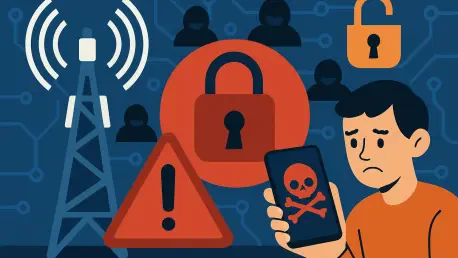In an era where cellular networks underpin the functionality of countless devices—from smart thermostats in homes to sophisticated industrial machinery in factories—a troubling question emerges: are these networks concealing significant security risks that could jeopardize entire systems? As the world becomes increasingly interconnected, billions of Internet of Things (IoT) devices and mission-critical equipment rely on cellular connectivity to operate seamlessly across public and private domains. Yet, beneath this veneer of convenience lies a stark reality: many organizations remain unaware of the vulnerabilities embedded in these networks. The long-standing assumption that mobile carriers inherently provide secure communication channels is proving to be a dangerous fallacy, exposing enterprises to cyber threats and compliance pitfalls. This article delves into the hidden dangers of cellular connectivity, examines the limitations of conventional security approaches, and explores a transformative model that could redefine protection in this digital landscape.
Uncovering the Vulnerabilities in Cellular Networks
The first major concern with cellular connectivity revolves around the alarming lack of visibility into device activities. Many organizations deploying IoT devices, such as smart sensors in urban infrastructure or tracking systems in fleet vehicles, have little to no insight into what these assets are doing once connected. Without robust monitoring mechanisms, data can be transmitted across international borders or unsecured networks without any oversight, creating fertile ground for cyberattacks. This blind spot is often rooted in misplaced confidence that cellular networks are secure by nature. Such an assumption overlooks the reality that these devices can operate autonomously, potentially engaging in unauthorized communications or exposing sensitive information. The absence of real-time tracking and control not only heightens the risk of data breaches but also complicates adherence to regulatory standards, leaving companies vulnerable to legal and financial repercussions.
Another critical issue lies in the inherent trust placed in mobile networks, which often lacks justification. Unlike tightly controlled IT environments, cellular networks frequently allow data to flow with minimal restrictions, making them an attractive target for malicious actors seeking to exploit weaknesses. Devices can roam across different regions, communicate without validation, and inadvertently leak confidential information without raising immediate red flags. This unchecked freedom amplifies the potential for threats to go undetected until significant damage has already occurred. The outdated belief that mobile carriers offer comprehensive protection ignores the evolving tactics of cybercriminals who capitalize on these gaps. As a result, organizations must confront the uncomfortable truth that their reliance on cellular systems, without additional safeguards, could be a ticking time bomb for security incidents and operational disruptions.
Limitations of Conventional Security Approaches
Traditional security tools, once considered reliable in older IT frameworks, are proving inadequate for the dynamic and fast-paced nature of cellular networks. Solutions like firewalls and virtual private networks (VPNs) were designed for more static environments and struggle to meet the real-time demands of modern IoT and mobile ecosystems. These legacy systems often fail to provide the detailed control necessary to scrutinize device traffic effectively, resulting in communications that go unverified. Moreover, implementing such tools in cellular contexts introduces unnecessary complexity and escalates costs without delivering proportionate protection. This gap in capability means that potential threats can slip through undetected, directly contradicting the principle of never assuming a connection is safe. The shortcomings of these conventional measures underscore the urgent need for a more adaptive and responsive security strategy tailored to today’s connectivity challenges.
Compounding the problem is the ever-expanding attack surface created by the widespread use of cellular devices across diverse networks. As these devices operate in both public and private domains, often without centralized oversight, they present numerous entry points for cybercriminals to exploit. Legacy security systems are ill-equipped to manage the distributed nature of such environments, leaving significant gaps in defense mechanisms. Risks ranging from data theft to unauthorized system access are magnified when devices function independently without stringent controls in place. The inability of traditional tools to scale effectively with the growing number of connected assets further exacerbates vulnerabilities, allowing threats to proliferate unchecked. This reality highlights a pressing need to rethink security architectures to ensure comprehensive protection against the sophisticated dangers lurking in cellular ecosystems.
Embracing a Zero Trust Model for Enhanced Protection
A promising solution to the security challenges of cellular networks is the adoption of a Zero Trust model, which fundamentally redefines how protection is approached. Unlike traditional methods that assume certain connections are inherently safe, Zero Trust operates on the premise that no interaction can be trusted without verification. Specifically designed for cellular connectivity, this framework emphasizes “visibility by design,” channeling all device traffic through a centralized platform for continuous, real-time inspection. By integrating security directly at the SIM or eSIM level, organizations can enforce detailed policies based on factors like user identity, geographic location, and behavioral patterns. Such measures effectively prevent unauthorized activities, such as data exfiltration or connectivity in restricted zones, providing a robust barrier against emerging cyber threats. This proactive stance represents a significant shift toward securing the vast and complex landscape of cellular communications.
The practical impact of Zero Trust is already evident across various industries, demonstrating its adaptability and effectiveness in addressing specific security needs. For instance, in the transportation sector, North American rail operators have successfully used this model to protect sensor data as it crosses international borders, ensuring seamless and secure operations. In manufacturing, Zero Trust safeguards access to critical systems on factory floors, maintaining operational integrity even under potential threats. Additionally, infrastructure monitoring for vital assets like bridges and buildings benefits from enhanced data integrity, supported by multi-carrier failover options and unified security policies. These real-world applications illustrate how Zero Trust can be tailored to meet the unique demands of different sectors, offering a versatile and powerful tool to combat the risks associated with cellular networks. The success of these implementations serves as a compelling argument for wider adoption of this innovative security paradigm.
Charting the Future of Cellular Security
Reflecting on the journey through the hidden risks of cellular connectivity, it becomes evident that past assumptions about the inherent safety of mobile networks have left organizations exposed to significant threats. The lack of visibility into device activities and the inadequacies of traditional security tools have compounded vulnerabilities across industries. However, the exploration of Zero Trust principles revealed a viable path to mitigate these dangers through rigorous verification and real-time oversight. Moving forward, enterprises must prioritize the integration of advanced security models like Zero Trust to gain control over their cellular ecosystems. Investing in platforms that offer comprehensive visibility and policy enforcement at the connectivity level will be crucial. Additionally, fostering collaboration between technology providers and industry stakeholders can drive the development of scalable solutions tailored to evolving threats. By taking these steps, the digital landscape can be fortified against unseen risks, ensuring a safer and more resilient connected world.









